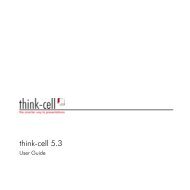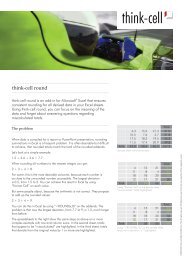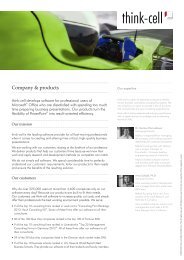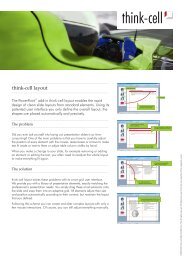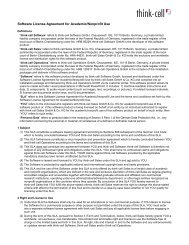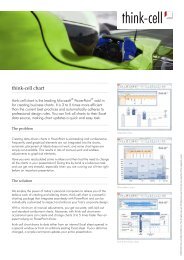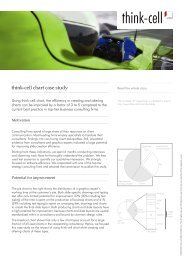think-cell technical report TC2003/01 A GUI-based Interaction ...
think-cell technical report TC2003/01 A GUI-based Interaction ...
think-cell technical report TC2003/01 A GUI-based Interaction ...
You also want an ePaper? Increase the reach of your titles
YUMPU automatically turns print PDFs into web optimized ePapers that Google loves.
4.3 Specifying the User Interface INTERACTION CONCEPT<br />
z-Axis<br />
(projection)<br />
(a) Appearance on the slide<br />
z = 8<br />
z = 6<br />
z = 7<br />
z = 5<br />
(c) Another possible z-order<br />
z-Axis<br />
z = 7<br />
z = 8<br />
z = 6<br />
z = 8<br />
(b) Possible z-order<br />
z = 7<br />
z = 6<br />
z = 5<br />
z = 5<br />
(d) Yet another possible z-order<br />
Figure 34: An example for an arrangement of shapes with wrong z-order<br />
(a) Appearance on the slide<br />
z = 8<br />
z = 7<br />
z = 5<br />
(b) “Side view”<br />
z = 6<br />
Figure 35: The same example as in Fig. 34 with the z-order corrected<br />
by a colored hairline between the shapes. Badros et al. [BNB00] suggest a similar<br />
representation for constraints between windows in a WIMP environment.<br />
Element-Specific Constraints<br />
Some more complex smart elements have specific constraints or settings that do not<br />
apply to other types of shapes. In the current prototype, each smart element has<br />
a contextual menu associated with it (Fig. 15). A right mouse button click opens<br />
the contextual menu of the selected smart element or elements. Depending on the<br />
type of the smart element, the contextual menu offers buttons for color, font size<br />
and the like. In the case of charts, for example, there are also options to turn labels<br />
and other specific features on or off.<br />
68



